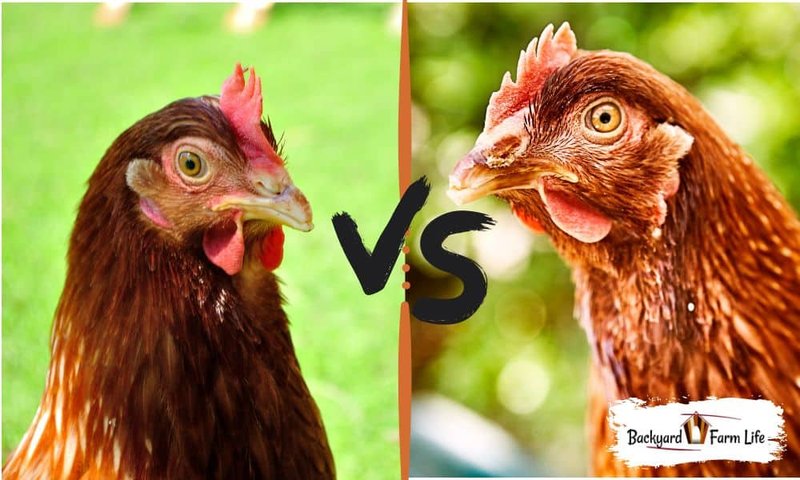
Imagine being in a room filled with different personalities. Some are bold and chatty, while others are laid back. Just like people, chickens have their own unique traits. Rhode Island Reds, for example, are known for being friendly yet independent, which is a balanced combo that many bird enthusiasts admire. In this article, we’ll dig into the characteristics of Rhode Island Reds and compare them to some closely related breeds, so you can appreciate the nuances between them.
What Makes Rhode Island Reds Unique?
First things first, let’s dive into what makes the Rhode Island Red breed so special. These chickens are well-loved, especially among backyard farmers, because of their friendly nature and robust health. They are generally hardy and can adapt well to different environments, which makes them great whether you live in a rural area or a suburban neighborhood.
Rhode Island Reds are known for their deep red feathers that shine in the sunlight. They have a calm demeanor, making them suitable for families who want pets that are both functional and friendly. Plus, they lay a decent number of brown eggs—about 250 to 300 a year! That’s quite a production for a small flock. Honestly, with their nurturing personalities and egg-laying prowess, they’re like the all-rounders of the chicken world.
Another key feature that sets Rhode Island Reds apart is their adaptability. Whether it’s hot summers or chilly winters, they can handle the temperatures with ease. This resilience is partly why farmers have chosen them for generations, and it’s a big reason they’ve become a staple of American poultry.
Comparing Rhode Island Reds to Plymouth Rocks
Now, let’s take a look at a similar breed: the Plymouth Rock. If Rhode Island Reds are the all-rounders, then Plymouth Rocks are like the charming companions with a sprinkle of flair. These birds have striking black-and-white striped feathers that resemble a zebra, which makes them quite the showstopper in any coop.
Both breeds are friendly, but Plymouth Rocks tend to be a bit more social. They enjoy human interaction and are likely to follow you around the yard, waiting for a treat. If you’re looking for a chicken that loves to form bonds, a Plymouth Rock might be the way to go. However, in terms of egg production, they do lag slightly behind Rhode Island Reds, laying about 200 to 250 eggs per year.
The overall size is another difference worth noting. Rhode Island Reds tend to be bulkier, while Plymouth Rocks are more petite. This can influence things like space requirements in a coop, so if you’re tight on room, you might want to consider how many birds you’d like to raise.
Rhode Island Reds vs. Sussex Chickens
Next up are the Sussex chickens, which come in various colors, with the white variety being the most common. Both Rhode Island Reds and Sussex chickens are known for their friendly temperaments, but there are some notable differences.
Sussex chickens are excellent layers, often producing around 250 to 300 eggs a year, which puts them on par with Rhode Island Reds in that department. However, Sussex birds are slightly larger and require more feed, which can be a concern if you’re looking to keep your feeding costs low.
Another point of comparison is their adaptability. While both breeds do well in different climates, Sussex chickens can be a bit more susceptible to cold. If you live in a place where winters are harsh, Rhode Island Reds might fare better in the long run.
In terms of personality, Sussex chickens are generally calmer and more docile than their Rhode Island Red counterparts. If you want birds that are easygoing and enjoy a leisurely peck around the yard, Sussex could be your best bet. But if you want layers with a bit more personality, Rhode Island Reds might shine brighter for you.
Differences in Egg Production
When it comes down to egg production, there’s a lot to consider. Both Rhode Island Reds and their counterparts—like Plymouth Rocks and Sussex chickens—are known for their prolific egg-laying capabilities. But how do they stack up in terms of consistency and quality?
Rhode Island Reds excel in producing brown eggs and are known for their dependable laying habits. They’re like that reliable friend who never misses a coffee date. On the other hand, while Plymouth Rocks may not lay as consistently, their eggs are still of good quality. Sussex chickens, as we mentioned earlier, also lay a significant amount but may not always match the consistency of Rhode Island Reds.
If you’re after reliable egg production, Rhode Island Reds might just take the crown. However, if you’re open to variety and a little unpredictability, both Plymouth Rocks and Sussex chickens can keep your egg basket interesting.
Health and Hardiness
Another critical factor to consider is health and hardiness. Rhode Island Reds are known for their robust health, which is a big reason they’re a popular choice among backyard farmers. They tend to be less prone to certain diseases and can handle various weather conditions, which gives them a significant advantage.
Plymouth Rocks and Sussex chickens, while generally healthy, can be a bit more susceptible to illnesses due to their physical characteristics. For instance, their feathered bodies might make them more prone to overheating in the summer months. If you live somewhere with extreme temperatures, Rhode Island Reds are likely your best bet for a hardy breed.
When selecting chickens, consider the health care required and the ability to withstand common poultry ailments. Rhode Island Reds are like the dependable friends who can tough it out, while other breeds may require a bit more attention and care.
So, when it comes down to choosing between Rhode Island Reds and similar bird species, it really depends on your preferences and needs. If you value hardiness, egg production, and a friendly demeanor, the Rhode Island Red is your best choice. They’ll give you a good yield of eggs and a charming companion in your backyard.
On the flip side, if you’re drawn to a bird that might have a more social personality or striking plumage, consider Plymouth Rocks or Sussex chickens. Each breed has its own charm and can be a wonderful addition to your homestead.
Ultimately, whether you’re choosing a Rhode Island Red or a different breed, it’s about finding the right fit for your lifestyle. Enjoy the journey of raising chickens, and may your backyard flock bring you joy and plenty of delicious eggs!

